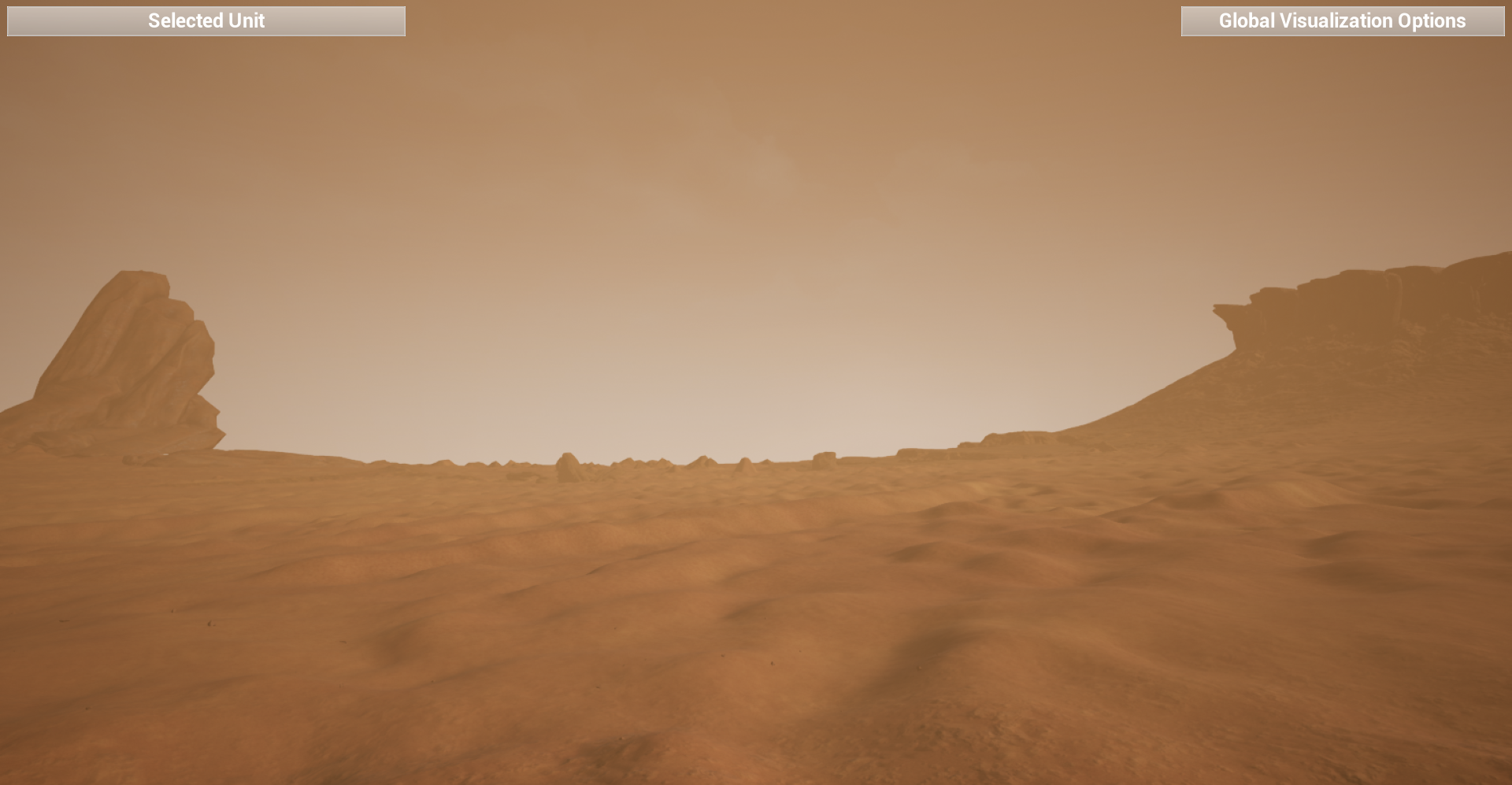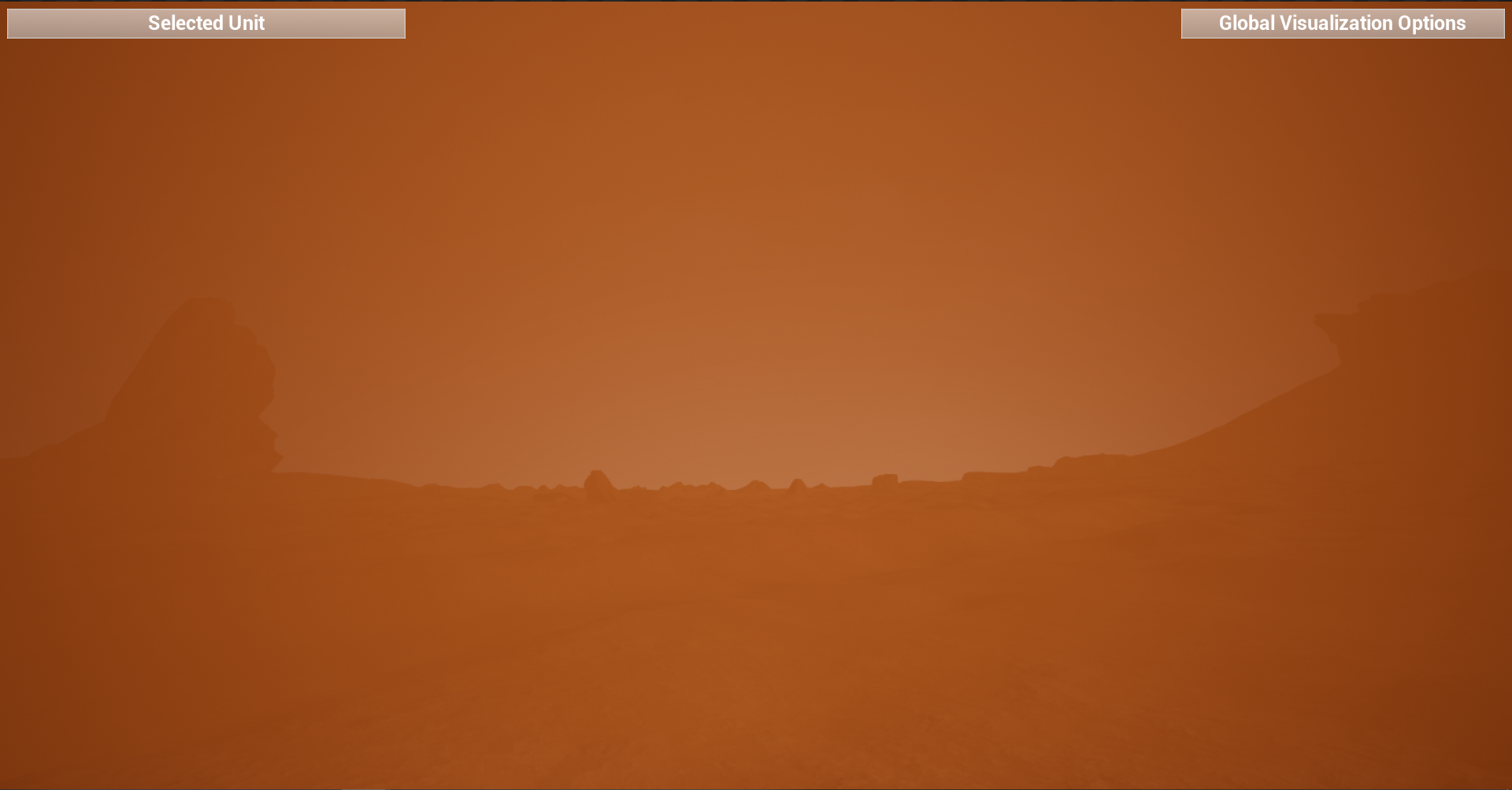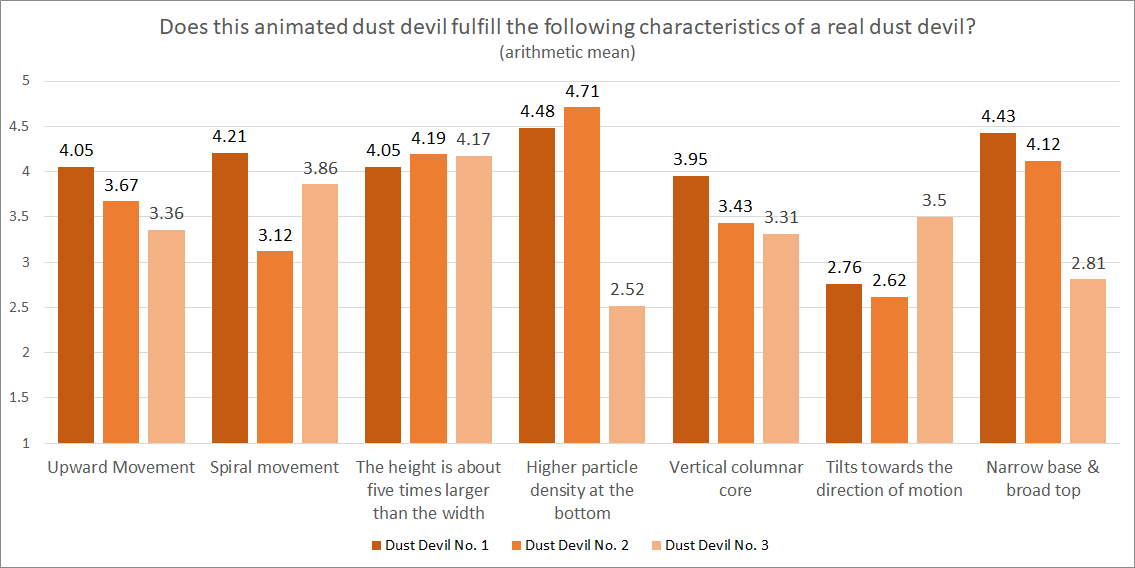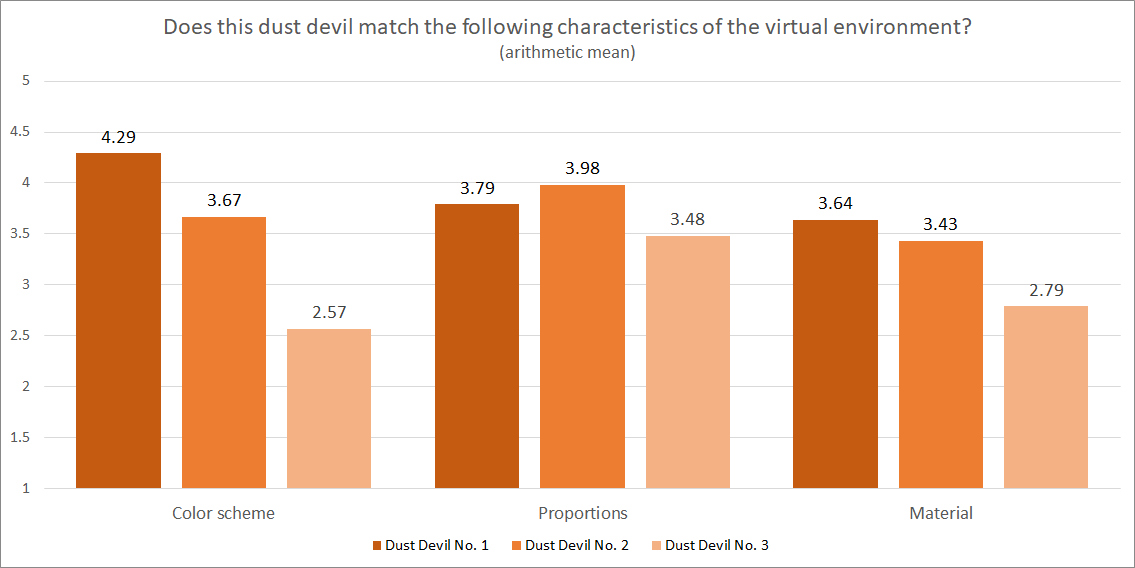Dust Devils and Dust Storms on Planet Mars - Animation and Simulation of Natural Phenomena
This bachelor’s thesis addresses the implementation of realistic natural phenomena in the virtual Mars environment of the Valles Marineris Exploration - Virtual TestBed (VaMEx-VTB) project. This includes animated dust devils, simulated dust storms, and a simulated atmosphere. The natural phenomena are used to extend the virtual Mars environment of the VaMEx-VTB project to provide a more realistic experience in consideration of the environmental influences and to extended the test scenarios for the testing of autonomous, heterogeneous swarm behavior on Mars terrain.
Description
The implementation of the natural phenomena of planet Mars provides three different animated
dust devils created according to the characteristics of real dust devils. This includes the shape, appearance,
and behavior of a dust devil. The image on the right shows the first dust devil on the left, the second dust devil in the middle,
and the third dust devil on the right side.
The first and second dust devil share the same basic implementation method and are both
animated in Unreal Engine 4. Each implementation is based on two vector fields generated with
3ds Max, a material created with Unreal Engine 4’s material editor, one particle system built
with Cascade, and an AI movement that utilizes blueprints. Both dust devils use the first vector
field to provide the helical shape of the dust devils rotating column of dust and the second to
form the circular moving dust at the bottom of the dust devil. Each particle system consists of
three particle emitters. Two emitters have the first vector field applied to them, to form the dust
devils’ torso and the third emitter uses the second vector field to create the moving dust cloud
at ground level. The difference between these two dust devils is the material. While a surface
material is applied to the first dust devil, the second dust devil uses a volume material.
The third dust devil, which is implemented inside Blender, also uses a particle system. Different
to the other two dust devils, the particle system defines the shape of the rotating dust column.
It is influenced by force fields, which cause, among others, the rotating movement. The smoke
of the smoke simulation forms according to the particles. Smoke simulation is part of the build
in fluid simulation of Blender. Also, a material is applied to the smoke, to give it the right color
and look of dust.
Two different dust storm simulations for the virtual Mars environment of the
VaMEx-VTB are provided. The first one uses exponential height fog and volumetric fog to create
a scene inside a large regional or global dust storm. By adding a particle system to a scene with volumetric fog enabled, the second dust storm simulation
is built. It controls the fog locally and produces a dust cloud. The AI movement applied to
it makes the dust cloud move independently through the landscape like a local or small regional dust storm.
The last natural phenomenon that is implemented is the Martian atmosphere. A particle system is created,
which is used to generate dust particles that float through the air.
These dust particles should simulate the presence of a dusty atmosphere in the virtual Mars environment in VaMEx-VTB.
The conducted user study is about the evaluation of the three animated dust devils. Next to the valuation of each dust devil, a comparison of
the animated dust devils with a real dust devil is included. Afterwards, scenes that show each
of the three dust devils integrated into the virtual mars environment of the VaMEx-VTB are
rated and also compared to each other. Also, the use of exponential height fog inside a dust devil scene is rated in the
study.
Results
The implemented natural phenomena extend the virtual testbed of the VaMEx-VTB project and provide a base
for a wider range of more realistic test scenarios. The dust devils and dust storms can have
an influence on the VSLAM algorithm of the robotic swarm of the VaMEx-VTB, which can
cause problems or mistakes in the navigation and orientation of the devices. Test scenarios like
dust devils that are recognized as landmarks by the visual sensors of the robotic swarm and
the limitation of view through a dust storm are provided through the integration of the natural
phenomena. The integration of the natural phenomena offers the wanted opportunity to expand the VaMEx-VTB, to test the possible impacts
of the phenomena on the robotic swarm, to provide a better preparation, and to minimize
possible problems through adequate testing.
The user study results show that the use of different materials for the first and second dust devil can make a significant difference in the rating of the dust devil, regarding an implementation close to reality and the overall impression. Also, the results show that the use of the fluid simulation of Blender has some advantages regarding the behavior and movement of the third dust devil, especially the tilting of the dust devil towards the direction of motion. Still, the fluid simulation of Blender loses against the dust devils build with Unreal Engine 4, regarding the easy integration and the overall impression.
The results of the user study in combination with the experiences of the implementation show that the easiest and best way to include a dust devil into the virtual Mars environment of the VaMEx-VTB is the implementation method of the second dust devil. It offers a simple integration, because it also uses Unreal Engine 4 and the ratings that the second dust devil gathers during the user study show that the implementation offers the best combination of realistic animation and harmony between the dust devil and the virtual environment of the VaMEx-VTB.
Files
Full version of the bachelor’s thesis (English only)
Colloquiums presentation: english version & german version
This video shows the first and second dust devil integrated into the virtual Mars environment of the VaMEx-VTB:
These videos show the two dust storm versions integrated into the virtual Mars environment of the VaMEx-VTB.
The large regional/global dust storm on the right and the local/small regional dust storm on the left:
License
This original work is copyright by University of Bremen.
Any software of this work is covered by the European Union Public Licence v1.2.
To view a copy of this license, visit
eur-lex.europa.eu.
The Thesis provided above (as PDF file) is licensed under Attribution-NonCommercial-NoDerivatives 4.0 International.
Any other assets (3D models, movies, documents, etc.) are covered by the
Creative Commons Attribution-NonCommercial-ShareAlike 4.0 International License.
To view a copy of this license, visit
creativecommons.org.
If you use any of the assets or software to produce a publication,
then you must give credit and put a reference in your publication.
If you would like to use our software in proprietary software,
you can obtain an exception from the above license (aka. dual licensing).
Please contact zach at cs.uni-bremen dot de.










